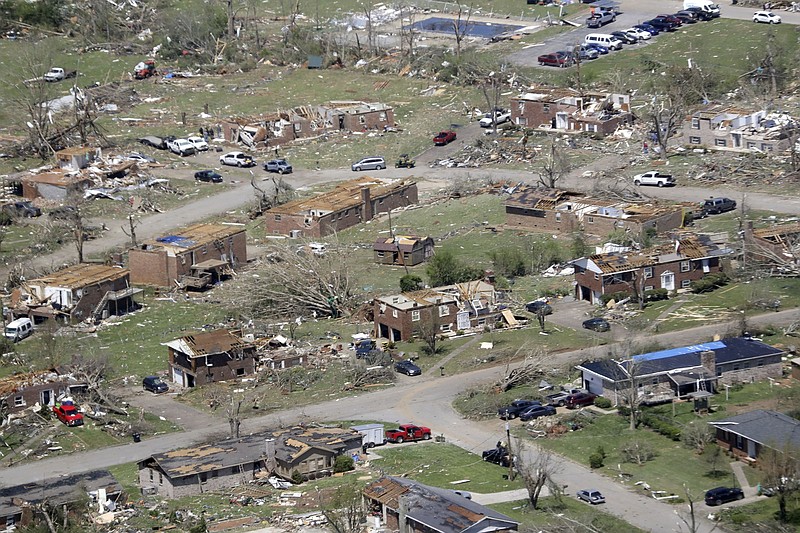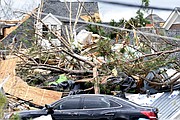A new study of federal weather data shows tornado activity in Tennessee and Georgia has increased by almost 36% in the past decade compared to activity from 2000-2009.
When comparing data from 2010-2019 to data from 2000-2009, Tennessee had 84 more tornadoes - an increase of 35.7% - and Georgia had 113 more tornadoes - an increase of 35.8%, according to a study from the insurance comparison marketplace firm QuoteWizard. Researchers analyzed National Oceanic and Atmospheric Administration data.
"We looked at the number of tornadoes in both Georgia and Tennessee over a 20-year period," company spokesperson Nathan Barber said, relating the national study to the Chattanooga region.
The report shows Georgia tied with New York for the 10th highest increase in tornadoes in the U.S. over the period, while Tennessee followed in the 12th spot.
A southerly shift in tornado activity is clearly shown in the weather data, said Nick VinZant, a senior research analyst with the firm.
"The numbers paint a pretty consistent pattern that we are seeing a decrease in the number of tornadoes in traditional 'Tornado Alley' areas like Kansas and Texas, and we're seeing more tornadoes in the South in places like Georgia, Tennessee and Kentucky," he said. "The most obvious factor in that regard is climate change. I think everything points to that."
While the number of tornadoes in the U.S.'s traditional Tornado Alley is decreasing, VinZant said, the area still has the majority of the nation's tornadoes.
"But Kansas, Texas and South Dakota have seen significantly fewer tornadoes, meanwhile, southern states like Louisiana, Kentucky and Mississippi have seen their number of tornadoes increase by 70% or more," VinZant said.
While the increase in Tennessee and Georgia was significant, Kentucky saw the most dramatic increase in the Southeast, with an 84.1% jump from 207 tornadoes in 2000-2009 to 381 in 2010-2019. That's followed by Mississippi's 74.8% increase and Louisiana's 70.4% increase, the study found.
Kentucky was edged out nationally by the greatest increase over the two-decade period that happened in Wyoming, where tornadoes nearly doubled, going from 81 in 2000-2009 to 157 in 2010-2019.
Key findings of the analysis show the overall number of tornadoes in the U.S. increased 11.7% in the study period, with Wyoming, Kentucky and Pennsylvania leading the way and South Dakota, Florida and South Carolina notching the largest decreases in activity.
Across the country, tornadoes from 2010-2019 caused more than $14.1 billion in damages. VinZant said the analysis didn't look at the prior decade on damage costs because "it wouldn't be an apples to apples comparison" due to differences in materials costs.
Not long after the Easter Sunday 2020 tornado outbreak raked the Chattanooga region with seven funnel clouds that left eight dead and dozens more ripped across much of the South, weather experts called it a textbook example of the eastward-shifting pattern of tornado activity.
(READ MORE: When night terrors are real: Tennessee leads nation for twisters in the dark)
National Weather Service records from spring 2020 show more than 100 tornadoes spun up across the South on Easter Sunday and Monday as a storm front raged through. Those storms left dozens dead and widespread destruction in Tennessee, Georgia, Alabama, Mississippi, Louisiana, North Carolina, South Carolina, Texas, Maryland and Florida, records show.
"This event we just saw, if you were to look up the definition in the dictionary of 'tornado vulnerability,' you would have this event right next to it," storm chaser and Northern Illinois University assistant professor of meteorology Victor Gensini said in 2020. "This was a classic event that would get you fatalities. It's in the right location, very vulnerable, it's overnight, and you had storms that were embedded in what we call line segments, which make tornadoes very difficult to detect and see, especially at night."
Gensini and Harold Brooks, a senior research scientist for the National Weather Service's National Severe Storms Laboratory in Norman, Oklahoma, worked together on a study on the trend published in October 2018 that looked at a decline in tornadoes in the Great Plains' Tornado Alley, while tornadoes in Southern states appeared to be on the rise in what some more recently refer to as "Dixie Alley."
Their article, published by nature.com, analyzed 1979-2017 tornado data after Gensini, Brooks and fellow scientists/storm chasers began developing a hunch that something about tornadoes was changing and should be studied.
"When we started looking at the data from the last 40 years or so, we began to notice that there's been some trends in tornado activity, and that is, we're seeing fewer tornadoes in the Great Plains - Texas, Oklahoma, Kansas, etc. - and an increase in places like Tennessee, Mississippi, Alabama and other portions of the mid-South," Gensini said.
Though increases don't appear dramatic over 40 years, "there are certainly increases that are statistically significant and important when you look at long-term trends of tornado climatology and tornado history," he said.
Brooks said tornado increases in southern states were slightly outpacing the decline in western states, but he warned it's easy to oversimplify those developments and it can be misleading to discuss the changes as related to "alleys," which are colloquial terms with no formal definitions.
There's no "safe" place, Brooks said.
Brooks and Gensini said the most troubling factor in the eastward shift is that population is more dense, increasing the likelihood of loss of life.
Exactly how a changing climate plays into these developments isn't known for certain.
"We don't really have a good physical model linking the change to global climate change," Brooks said. "That doesn't mean that's not the cause. It's just that there isn't a complete chain of solid links."
The impact from increasing tornadoes also rings up a tally in damage costs but they're hard to track, according to VinZant.
"What we found when you look at Tennessee over the last decade, $725,434,000 in damages have been caused by tornadic activity, in Georgia, $661,225,000," VinZant said, noting again the decision not to compare damage figures decade-to-decade.
"But it's tough to point to a pattern in that regard because one tornado can do hundreds of millions of dollars in damage while you could have 10 tornadoes in a rural area that didn't do too much," he said. "We felt like the amount of damage was not an actual indication of a pattern."
However, the data shows a southeastern shift of tornado activity is real and in some cases very substantial, he said.
"What we see on a national level is the huge, huge increases in tornadic activity in the South, and smaller decreases of about 10%-20% in Tornado Alley," he said. "So there really is a shift in the number of tornadoes in the country."
Contact Ben Benton at bbenton@timesfreepress.com or 423-757-6569. Follow him on Twitter @BenBenton.

